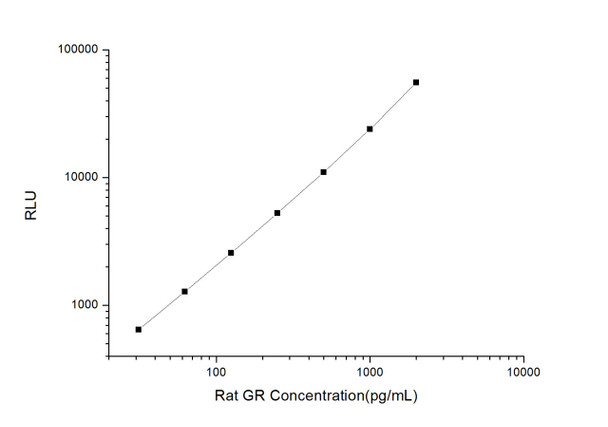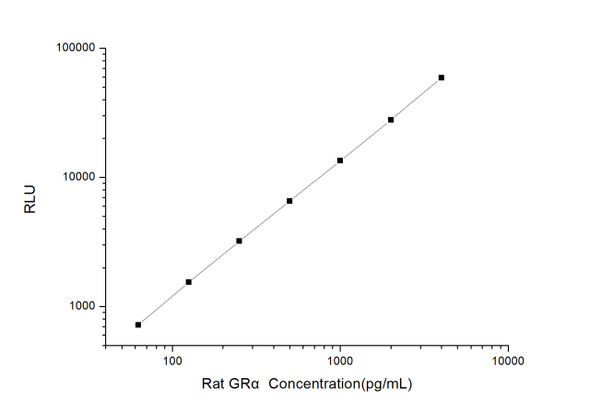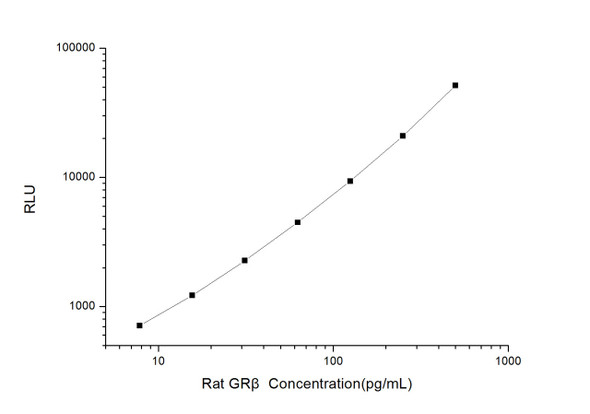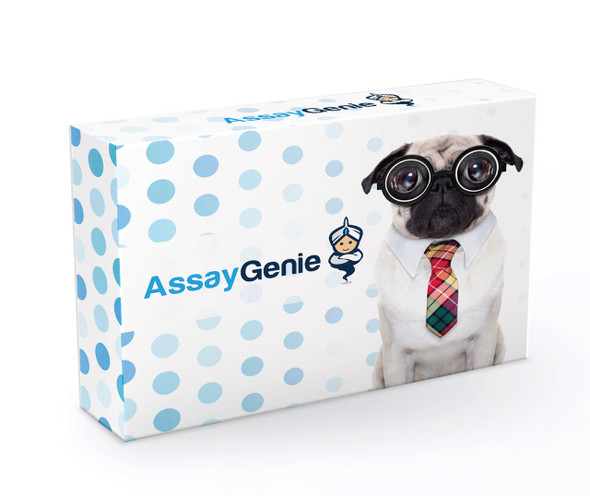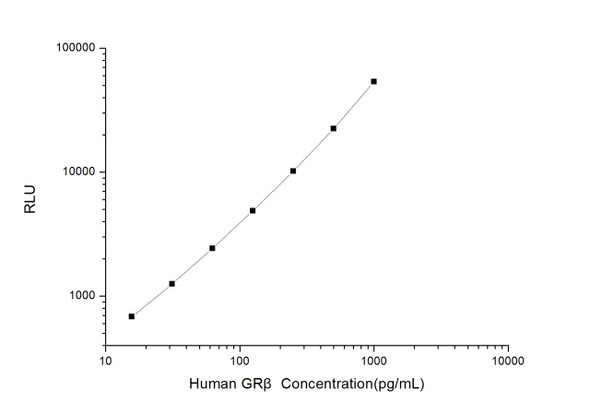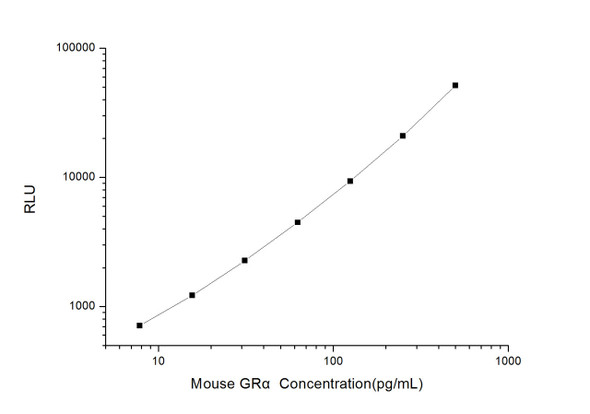Rat Signaling ELISA Kits 3
Rat GR (Glucocorticoid Receptor) CLIA Kit (RTES00239)
- SKU:
- RTES00239
- Product Type:
- ELISA Kit
- ELISA Type:
- CLIA Kit
- Size:
- 96 Assays
- Sensitivity:
- 18.75pg/mL
- Range:
- 31.25-2000pg/mL
- ELISA Type:
- Sandwich
- Reactivity:
- Rat
- Sample Type:
- Serum, plasma and other biological fluids
- Research Area:
- Epigenetics and Nuclear Signaling
Description
| Assay type: | Sandwich |
| Format: | 96T |
| Assay time: | 4.5h |
| Reactivity: | Rat |
| Detection method: | Chemiluminescence |
| Detection range: | 31.25-2000 pg/mL |
| Sensitivity: | 18.75 pg/mL |
| Sample volume: | 100µL |
| Sample type: | Serum, plasma and other biological fluids |
| Repeatability: | CV < 15% |
| Specificity: | This kit recognizes Rat GR in samples. No significant cross-reactivity or interference between Rat GR and analogues was observed. |
This kit uses Sandwich-CLIA as the method. The micro CLIA plate provided in this kit has been pre-coated with an antibody specific to Rat GR. Standards or samples are added to the appropriate micro CLIA plate wells and combined with the specific antibody. Then a biotinylated detection antibody specific for Rat GR and Avidin-Horseradish Peroxidase (HRP) conjugate are added to each micro plate well successively and incubated. Free components are washed away. The substrate solution is added to each well. Only those wells that contain Rat GR, biotinylated detection antibody and Avidin-HRP conjugate will appear fluorescence. The Relative light unit (RLU) value is measured spectrophotometrically by the Chemiluminescence immunoassay analyzer. The RLU value is positively associated with the concentration of Rat GR. The concentration of Rat GR in the samples can be calculated by comparing the RLU of the samples to the standard curve.
| UniProt Protein Function: | GR: transcription factor of the nuclear receptor family. Receptor for glucocorticoids (GC). Binds to glucocorticoid response elements (GRE) and modulates other transcription factors. Affects inflammatory responses, cellular proliferation and differentiation in target tissues. Three alternatively spliced isoforms have been described. |
| UniProt Protein Details: | Protein type:Transcription factor; DNA-binding; Mitochondrial; Nuclear receptor Chromosomal Location of Human Ortholog: 5q31. 3 Cellular Component: nucleoplasm; membrane; mitochondrial matrix; cytoplasm; cytosol; nucleus Molecular Function:protein dimerization activity; glucocorticoid receptor activity; protein binding; zinc ion binding; transcription factor activity; steroid binding Biological Process: transcription from RNA polymerase II promoter; transcription initiation from RNA polymerase II promoter; transcription, DNA-dependent; maternal behavior; adrenal gland development; regulation of glucocorticoid biosynthetic process; chromatin modification; signal transduction; glucocorticoid metabolic process; glucocorticoid mediated signaling; regulation of transcription, DNA-dependent; positive regulation of neuron apoptosis; glucocorticoid receptor signaling pathway; gene expression; positive regulation of transcription from RNA polymerase II promoter; regulation of gluconeogenesis Disease: Glucocorticoid Resistance, Generalized |
| NCBI Summary: | This gene encodes glucocorticoid receptor, which can function both as a transcription factor that binds to glucocorticoid response elements in the promoters of glucocorticoid responsive genes to activate their transcription, and as a regulator of other transcription factors. This receptor is typically found in the cytoplasm, but upon ligand binding, is transported into the nucleus. It is involved in inflammatory responses, cellular proliferation, and differentiation in target tissues. Mutations in this gene are associated with generalized glucocorticoid resistance. Alternative splicing of this gene results in transcript variants encoding either the same or different isoforms. Additional isoforms resulting from the use of alternate in-frame translation initiation sites have also been described, and shown to be functional, displaying diverse cytoplasm-to-nucleus trafficking patterns and distinct transcriptional activities (PMID:15866175). [provided by RefSeq, Feb 2011] |
| UniProt Code: | P06536 |
| NCBI GenInfo Identifier: | 4504133 |
| NCBI Gene ID: | 2908 |
| NCBI Accession: | NP_000167. 1 |
| UniProt Secondary Accession: | P06536,P06537, P06536, |
| UniProt Related Accession: | P04150 |
| Molecular Weight: | |
| NCBI Full Name: | glucocorticoid receptor isoform alpha |
| NCBI Synonym Full Names: | nuclear receptor subfamily 3 group C member 1 |
| NCBI Official Symbol: | NR3C1 |
| NCBI Official Synonym Symbols: | GR; GCR; GRL; GCCR; GCRST |
| NCBI Protein Information: | glucocorticoid receptor |
| UniProt Protein Name: | Glucocorticoid receptor |
| UniProt Synonym Protein Names: | Nuclear receptor subfamily 3 group C member 1 |
| UniProt Gene Name: | NR3C1 |
| UniProt Entry Name: | GCR_HUMAN |
As the RLU values of the standard curve may vary according to the conditions of the actual assay performance (e. g. operator, pipetting technique, washing technique or temperature effects), the operator should establish a standard curve for each test. Typical standard curve and data is provided below for reference only.
| Concentration (pg/mL) | RLU | Average | Corrected |
| 2000 | 51986 59456 | 55721 | 55693 |
| 1000 | 22274 25674 | 23974 | 23946 |
| 500 | 11656 10408 | 11032 | 11004 |
| 250 | 5049 5539 | 5294 | 5266 |
| 125 | 2724 2492 | 2608 | 2580 |
| 62.5 | 1390 1232 | 1311 | 1283 |
| 31.25 | 648 700 | 674 | 646 |
| 0 | 27 29 | 28 | -- |
Precision
Intra-assay Precision (Precision within an assay): 3 samples with low, mid range and high level Rat GR were tested 20 times on one plate, respectively.
Inter-assay Precision (Precision between assays): 3 samples with low, mid range and high level Rat GR were tested on 3 different plates, 20 replicates in each plate.
| Intra-assay Precision | Inter-assay Precision | |||||
| Sample | 1 | 2 | 3 | 1 | 2 | 3 |
| n | 20 | 20 | 20 | 20 | 20 | 20 |
| Mean (pg/mL) | 98.91 | 196.48 | 690.66 | 106.70 | 200.99 | 735.86 |
| Standard deviation | 9.06 | 20.96 | 77.84 | 10.26 | 15.72 | 75.13 |
| C V (%) | 9.16 | 10.67 | 11.27 | 9.62 | 7.82 | 10.21 |
Recovery
The recovery of Rat GR spiked at three different levels in samples throughout the range of the assay was evaluated in various matrices.
| Sample Type | Range (%) | Average Recovery (%) |
| Serum (n=5) | 91-105 | 96 |
| EDTA plasma (n=5) | 86-98 | 92 |
| Cell culture media (n=5) | 88-101 | 93 |
Linearity
Samples were spiked with high concentrations of Rat GR and diluted with Reference Standard & Sample Diluent to produce samples with values within the range of the assay.
| Serum (n=5) | EDTA plasma (n=5) | Cell culture media (n=5) | ||
| 1:2 | Range (%) | 92-108 | 91-107 | 99-116 |
| Average (%) | 99 | 97 | 106 | |
| 1:4 | Range (%) | 91-106 | 89-103 | 89-103 |
| Average (%) | 99 | 94 | 97 | |
| 1:8 | Range (%) | 91-104 | 99-114 | 91-103 |
| Average (%) | 98 | 104 | 98 | |
| 1:16 | Range (%) | 95-106 | 98-111 | 87-98 |
| Average (%) | 100 | 105 | 93 |
An unopened kit can be stored at 4°C for 1 month. If the kit is not used within 1 month, store the items separately according to the following conditions once the kit is received.
| Item | Specifications | Storage |
| Micro CLIA Plate(Dismountable) | 8 wells ×12 strips | -20°C, 6 months |
| Reference Standard | 2 vials | |
| Concentrated Biotinylated Detection Ab (100×) | 1 vial, 120 µL | |
| Concentrated HRP Conjugate (100×) | 1 vial, 120 µL | -20°C(shading light), 6 months |
| Reference Standard & Sample Diluent | 1 vial, 20 mL | 4°C, 6 months |
| Biotinylated Detection Ab Diluent | 1 vial, 14 mL | |
| HRP Conjugate Diluent | 1 vial, 14 mL | |
| Concentrated Wash Buffer (25×) | 1 vial, 30 mL | |
| Substrate Reagent A | 1 vial, 5 mL | 4°C (shading light) |
| Substrate Reagent B | 1 vial, 5 mL | 4°C (shading light) |
| Plate Sealer | 5 pieces | |
| Product Description | 1 copy | |
| Certificate of Analysis | 1 copy |
- Set standard, test sample and control (zero) wells on the pre-coated plate and record theirpositions. It is recommended to measure each standard and sample in duplicate. Note: addall solutions to the bottom of the plate wells while avoiding contact with the well walls. Ensuresolutions do not foam when adding to the wells.
- Aliquot 100µl of standard solutions into the standard wells.
- Add 100µl of Sample / Standard dilution buffer into the control (zero) well.
- Add 100µl of properly diluted sample (serum, plasma, tissue homogenates and otherbiological fluids. ) into test sample wells.
- Cover the plate with the sealer provided in the kit and incubate for 90 min at 37°C.
- Aspirate the liquid from each well, do not wash. Immediately add 100µL of BiotinylatedDetection Ab working solution to each well. Cover the plate with a plate seal and gently mix. Incubate for 1 hour at 37°C.
- Aspirate or decant the solution from the plate and add 350µL of wash buffer to each welland incubate for 1-2 minutes at room temperature. Aspirate the solution from each well andclap the plate on absorbent filter paper to dry. Repeat this process 3 times. Note: a microplatewasher can be used in this step and other wash steps.
- Add 100µL of HRP Conjugate working solution to each well. Cover with a plate seal andincubate for 30 min at 37°C.
- Aspirate or decant the solution from each well. Repeat the wash process for five times asconducted in step 7.
- Add 100µL of Substrate mixture solution to each well. Cover with a new plate seal andincubate for no more than 5 min at 37°C. Protect the plate from light.
- Determine the RLU value of each well immediately.

